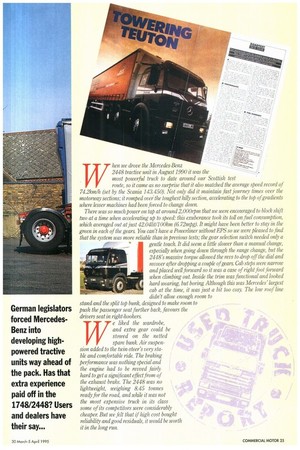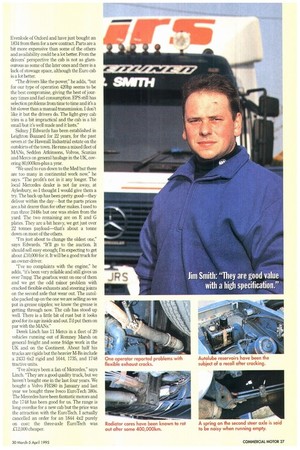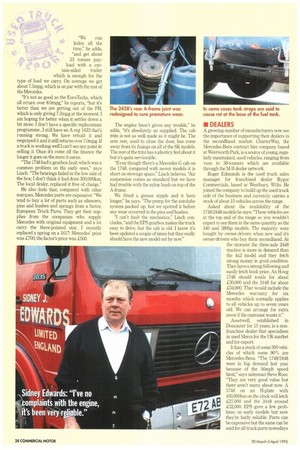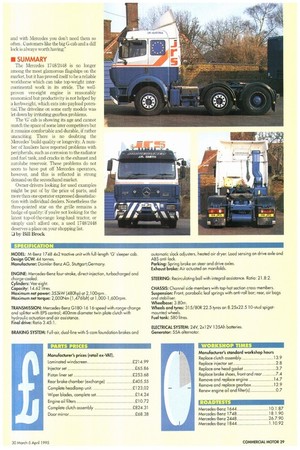THE POINER 0 DELIVER
Page 26

Page 27

Page 28

Page 29

Page 30

Page 31

If you've noticed an error in this article please click here to report it so we can fix it.
• When the German Federal Republic set an 8hp/tonne power-to-weight ratio back in 1971 Mercedes-Benz was forced to produce vehicles with 30% more power than was required anywhere else in Europe. But this cloud had a generous silver lining: long before anyone was predicting operators' demand for more power, M-B was forcing the pace with its 0M400 Series vee engine. At about the same time the new generation' cab was under development; it came on line three years later as a day cab and two sizes of sleeper. Although they were updated superficially for the eighties and again for the nineties, these cabs are still in service with much the same basic shell.
• EVOLUTION
Turbocharging boosted the 14.62-litre engine to 350hp; in 1986 charge-cooling took it to 440hp. When the Powerliner 2 tractors were introduced in August 1988—uprated to 17 tonnes and 24 tonnes with a sleeper cab as standard—the turbocharged vee-eight was ■
TT hen we drove the Mercedes-Benz ft
2448 tractive unit in August 1990 it was the most powerful truck to date around our Scottish test route, so it came as no surprise that it also matched the average speed record of 74.2km/h (set by the Scania 143.450). Not only did it maintain fast journey times over the motorway sections; it romped ovei the toughest hilly section, accelerating to the top of gradients where lesser machines had been forced to change down.
There was so much power on tap at around 2,000rpm that we were encouraged to block shift two at a time when accelerating up to speed: this exuberance took its toll on fuel consumption, which averaged out at just 42.041it/100km (6.72mpg). It might have been better to stay in the green in each of the gears. You can't have a Powerliner without EPS so we were pleased to find that the system was more reliable than in previous tests; the gear selection switch needed only a gentle touch It did seem a little slower than a manual change, especially when going down through the range change, but the 2448's massive torque allowed the revs to drop off the dial and recover after dropping a couple of gears. Cab steps were narrow and placed well forward so it was a case of right foot forward when climbing out. Inside the trim was functional and looked hard wearing, but boring Although this was Mercedes' largest cab at the time, it was just a bit too cosy. The low roof line didn't allow enough room to
stand and the split top bunk, designed to make room to push the passenger seat further back, favours the drivers seat in right-hookers.
We liked the wardrobe, and extra gear could be stowed on the netted spare bunk. Air suspension added to the twin-steer's very stable and comfortable ride. The braking performance was nothing special and the engine had to be revved fairly hard to get a significant effect from of the exhaust brake. The 2448 was no lightweight, weighing 8.45 tonnes ready for the road, and while it was not the most expensive truck in its class some of its competitors were considerably cheaper But we felt that if high cost bought reliability and good residuals, it would be worth it in the long run. joined by the lighter 10.96
litre 330hp charge-cooled vee-six. The 480hp 1748 and 24-48 flag ships arrived in September 1988 with the widest "Grossraum kabine" or `G' cab as standard: high-roof models followed in 1992 with more height and additional storage space.
With the launch of the Powerliner 2 models, in September 1988, EPS (electronic power shift) became standard on all but the heavyduty 6x4 tractive units. The 16-speed ZF box was dropped in favour of a similar fully synchromesh unit produced in-house. Chassis lube became a standard item.
The M-B constantly open throttle valvetype engine brake was claimed to be up to twice as powerful as a conventional butterflytype exhaust brake: in August 1990 it became an option on six and eight-cylinder engines.
During 1991 Mercedes-Benz added a 350hp double-drive tractive unit to its UK line-up: German legislation subsequently pushed up the design weight, and hence the model prefixes, to 18 and 25. From April 1992 503hp 4x2s and 6x2s replaced the 480hp versions. Last year the 2538, with a 7.5-tonne front axle, replaced the earlier 6x4 tractor. The Euro-2 vee-eight is now rated at 530hp. Jim Smith started up in transport as JR Smith 40 years ago at Tring; one of his two sons has now joined him in the business They run a smart fleet of 14 tractive units in blue and grey livery along with 30 full-length box and curtain sided semi-trailers. The fleet is something of a mix, including Scanias, Volvos, MANs, Mercs, Ivecos and Renaults. They cover some 100,000km a year running as far afield as Greece. Smith takes advantage of the tax concession gained from running on six axles but says that his Mercs are heavy so he only gets a payload of 22.5 tonnes tops. He finds that three-axle units tend to be more stable and give better traction in bad weather. Running in the UK he gets 7.5-8.0mpg, but up to 9.0mpg running on the Continent.
"We run two Mercedes now but we did have five at one stage," he says. "Originally we had a little 814 7.5-tonner, which was good, so when the 1644 was introduced we liked the look of it and bought two. They were also very good and then we bought three 48s when they were introduced. They were on F-plates and I think we were the first in the country to run them but the gearboxes gave trouble; they just lost their drive. All of them were rebuilt and one of them twice; first at 90,000km and again at 300,000km. The work was covered by the driveline warranty Other faults include the mirror arms cracking but there has been a design change on the later ones. The 2448 has an A-frame at the rear and the joint above the differential wore out very quickly.
"The exhaust blows onto the lower suspension arm on the offside and melts the rubber," he adds. "The radiators gave us a problem— the cores at the bottom rot after about 400,0001cm. Tank straps caused the bottom of fuel tanks to rust. There was a recall on the autolube system to replace the reservoirs; they cracked at the bottom where the bolts go through. The middle spring on the second steer axle chatters and is very noisy when running empty."
One of the vee-eights in the 48s was a complete disaster, Smith recalls, "It just didn't deliver the power. After three months it was stripped down and they discovered that no oil control rings had been fitted by the factory. It was never any good when it came back so we got rid of it. Tyres last a bit longer than on the Scania twin steers. We normally change trucks at five years but if they are good we keep them going a bit longer. We have only just sold one of the 1644s we bought in 1986. Since our initial problems with the 48s they have got better and better and been virtually trouble free over the last two years. Residuals are slightly better than average.. .not as good as for Scania or Volvo, but they are good value with a high specification and we never have any trouble selling them. We deal with Evenlode of Oxford and have just bought an 1834 from them for a new contract. Parts are a bit more expensive than some of the others and availability could be a lot better. From the drivers' perspective the cab is not as glamourous as some of the later ones and there is a lack of stowage space, although the Euro cab is a lot better.
"The drivers like the power," he adds, but for our type of operation 420hp seems to be the best compromise, giving the best of jour ney times and fuel consumption. EPS still has selection problems from time to time and it's a bit slower than a manual transmission. I don't like it but the drivers do. The light-grey cab trim is a hit impractical and the cab is a bit small but it's well made and it lasts."
Sidney J Edwards has been established in Leighton Buzzard for 22 years, for the past seven at the Hawmill Industrial estate on the outskirts of the town. He runs a mixed fleet of MANs, Seddon Atkinsons, Volvos, Scanias and Mercs on general haulage in the UK, covering 80,000Irdn-plus a year.
"We used to run down to the Med but there are too many in continental work now." he says. The profit's not in it any longer. The local Mercedes dealer is not far away, at Aylesbury, so I thought I would give them a try. The back-up has been pretty good—they deliver within the day—but the parts prices are a bit dearer than for other makes. I used to run three 2448s but one was stolen from the yard. The two remaining are on E and G plates. They are a bit heavy, we get just over 22 tonnes payload—that's about a tonne down on most of the others.
"I'm just about to change the oldest one," says Edwards. "It'll go to the auction. It should sell easy enough; I'm expecting to get about £10,000 for it. It will be a good truck for an owner-driver.
"I've no complaints with the engine," he adds, "it's been very reliable and still gives us over 7mpg. The gearbox went on one of them and we get the odd minor problem with cracked flexible exhausts and steering joints on the second axle that wear out. The autol ube packed up on the one we are selling so we put in grease nipples; we know the grease is getting through now. The cab has stood up well. There is a little bit of rust but it looks good for its age inside and out. I'd put them on par with the MANs."
Derek Linch has 11 Mercs in a fleet of 20 vehicles running out of Romney Marsh on general freight and some fridge work in the UK and on the Continent. About half his trucks are rigids but the heavier M-Bs include a 2433 6x2 rigid and 1644, 1735, and 1748 tractive units.
"I've always been a fan of Mercedes," says Linch. "They are a good quality truck, but we
haven't bought one in the last four years. We bought a Volvo FH380 in January and last year we bought three Iveco EuroTech 380s.
The Mercedes have been fantastic motors and the 1748 has been good for us. The range is long overdue for a new cab but the price was the attraction with the EuroTech. I actually cancelled an order for an 1844 4x2 purely on cost: the three-axle EuroTech was £12.000 cheaper. "We run laden all the time," he adds, "and get about 23 tonnes pay tam-sided trailer 0 0 load with a cur which is enough for the type of load we carry. On average we get about 7.5mpg, which is on par with the rest of the Mercedes.
"It's not as good as the EuroTechs, which all return over 8.0mpg," he reports, "but it's better than we are getting out of the FH, which is only giving 7.2mpg at the moment. I am hoping for better when it settles down a bit more. I don't have a specific replacement programme...I still have an A reg 1633 that's running strong. We have rebuilt it and resprayed it and it still returns over 7.0mpg. If a truck is working well I can't see any point in selling it. Once it's come off the finance the longer it goes on the more it earns.
"The 1748 had a gearbox fault which was a common problem on the early ones," says Linch. "The bearings failed in the low side of the box; I don't think it had done 300,000km. The local dealer, replaced it free of charge."
He also feels that, compared with other marques, Mercedes parts are expensive: "We tend to buy a lot of parts such as silencers, pins and bushes and springs from a factor, European Truck Parts. They get their supplies from the companies who supply Mercedes with original equipment and a lot carry the three-pointed star. I recently replaced a spring on a 1617: Mercedes' price was £700; the factor's price was £500.
The engine hasn't given any trouble," he adds, "it's absolutely as supplied. The cab trim is not as well made as it might be. The arm rest, used to close the door, has come away from its fixings on all of the SK models. The rest of the trim has a plasticy feel about it but it's quite serviceable.
"Even though there's a Mercedes G cab on the 1748, compared with newer models it is short on stowage space," Linch believes. 'Air suspension comes as standard but we have had trouble with the nylon bush on top of the A-frame.
We fitted a grease nipple and it lasts longer," he says. "The pump for the autolube system packed up, but we spotted it before any wear occurred in the pins and bushes.
"I can't fault the mechanics," Linch concludes, "and the EPS gearbox makes the truck easy to drive, but the cab is old. I know it's been updated a couple of times but they really should have the new model out by now." A growing number of manufacturers now see the importance of supporting their dealers in the secondhand market, CharterWay, the Mercedes-Benz contract hire company based at Wentworth Park, is a source of young, regularly maintained, used vehicles, ranging from vans to 38-tonners which are available through the MB dealer network.
Roger Edmunds is the used truck sales manager for franchised dealer Rygor Commercials, based at Westbury, Wilts. He joined the company to build up the used truck side of the business and currently carries a stock of about 15 vehicles across the range.
Asked about the availability of the 1748/2448 models he says: "These vehicles are at the top end of the range so you wouldn't expect to see them in the same quantity as the 340 and 380hp models. The majority were bought by owner-drivers when new and it's owner-drivers who buy them secondhand. At the moment the three-axle 2448 tractive is more in demand than the 4x2 model and they fetch strong money in good condition. They have a strong following and easily fetch book price. An H-reg 1748 should resale for about £30,000 and the 2448 for about £34,000. That would include the Mercedes warranty for six months which normally applies to all vehicles up to seven years old. We can arrange for extra cover if the customer wants it."
Assetwell, established in Doncaster for 15 years, is a nonfranchise dealer that specialises in used Mercs for the UK market and for export.
It has a stock of some 300 vehicles of which some 90% are Mercedes-Benz. "The 1748/2448 were in big demand last year because of the 56mph speed limit," says salesman Steve Ross: "They are very good value but there aren't many about now. A 1748 on an H-plate with 450,000km on the clock will fetch £27,000 and the 2448 around £32,000. EPS gave a few problems on early models but now they're fairly reliable. Parts can be expensive but the same can be said for all truck parts nowadays and with Mercedes you don't need them so often . Customers like the big G-cab and a diff lock is always worth having."
The Mercedes 1748/2448 is no longer among the most glamorous flagships on the market, but it has proved itself to be a reliable workhorse which can take top-weight intercontinental work in its stride. The wellproven vee-eight engine is reasonably economical but productivity is not helped by kerbweight, which eats into payload potential.The driveline on some early models was let down by irritating gearbox problems.
The 'G' cab is showing its age and cannot match the space of some later competitors but it remains comfortable and durable, if rather unexciting. There is no doubting the Mercedes' build quality or longevity. A number of hauliers have reported problems with peripherals, such as corrosion to the radiator and fuel tank, and cracks in the exhaust and autolube reservoir. These problems do not seem to have put off Mercedes operators, however, and this is reflected in strong demand on the secondhand market.
Owner-drivers looking for used examples might be put of by the price of parts, and more than one operator expressed dissatisfaction with individual dealers. Nonetheless the three-pointed star on the grille remains a badge of quality: if you're not looking for the latest top-of-the-range long-haul tractor, or simply can't afford one, a used 1748/2448 deserves a place on your shopping list.
































































































